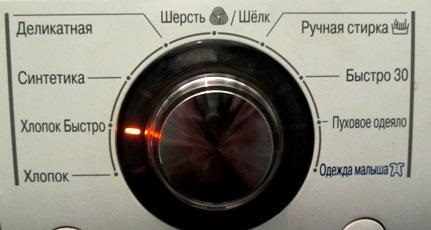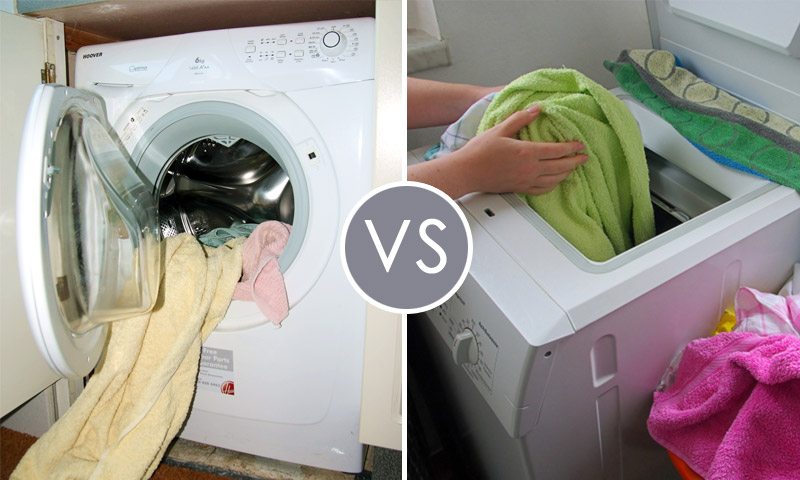The washing machine turns on but does not start washing
 Typical washing machine malfunctions include problems in which the machine does not start the wash. In such cases, the washing machine turns on every once in a while or does not respond at all to user commands. The start of the unit is blocked by both broken UBLs and failed selectors, the engine or problems with electronics. Most of the damage can be fixed with your own hands at home.
Typical washing machine malfunctions include problems in which the machine does not start the wash. In such cases, the washing machine turns on every once in a while or does not respond at all to user commands. The start of the unit is blocked by both broken UBLs and failed selectors, the engine or problems with electronics. Most of the damage can be fixed with your own hands at home.
Closing sensor on the “vertical”
On top-loading washing machines, problems with starting are often caused by a loading hatch blocker. This is a limit switch that prevents the control board from starting the wash when the drum is open. Also, on some models, this device is also responsible for collecting water into the tank.
If the limit switch is broken, the module does not receive an enabling signal and the machine does not start. To correct the situation, it is necessary to remove the “blocking”. To do this, we check the device for faults.
On “verticals”, a malfunction of the limit sensor prevents the start.
The switch is located under the top panel of the washing machine. The blocker is activated by a special pin, which is located on the loading hatch cover. If the drum is closed, then the protection is triggered. If there is no start, you need to check:
- is there any mechanical damage to the sensor device;
- are the levers and other mechanisms of the “locker” in good working order;
- Is the contact group of the switch stuck?
When the switch is activated, but the collection of water into the drum does not begin and the engine is “silent”, then there is a breakdown of the “blocker”.This means you need to remove the device and check its functionality. We proceed like this:
- disconnect the washing machine from the power supply;
- release the wiring from the switch terminals;
- We connect a multimeter to the blocker and measure the indicators.
If the malfunction is confirmed, you should dismantle the old device and install a new one. It is strongly not recommended to repair the switch by closing the contact group with a jumper. Such manipulations violate the conditions for safe operation of the washing machine and can lead to spontaneous combustion.
Hatch locking device
A front-loading washing machine does not start washing if the hatch locking device is faulty. The UBL is built into the door frame (or into the lock itself) and closes only when the door is completely locked. If the drum is not closed tightly, the lock does not work and the wash does not start.
If the machine does not start, the UBL is checked first. It is necessary to verify the functionality of the sensor and the integrity of the contacts. To do this, disconnect the washing machine from the power supply, remove the top cover, release the wiring from the blocker and remove the device from the housing. Then we connect a multimeter to the blocker and measure the indicators.
Checking selectors
Problems with the selector also prevent the washing machine from starting. When switching the programmer, the selector handle must be pulled out and locked in the new position. If this does not happen, then the desired mode is not selected and the machine does not start the cycle.
The washing machine does not turn on when the programmer is not working.
The selector is part of the timer, but this does not prevent you from checking its functionality with a multimeter. We proceed like this:
- disconnect the washing machine from the power supply;
- remove the top cover of the unit;
- We study the electrical circuit of the device and find the timer contacts;
- We call contacts.

Modern electronically controlled machines are equipped with a digital programmer. This switch is not tied to the timer, but is built into the control board circuit. It is more difficult to check such a device: it is necessary to connect the probes by activating the “Start” button.
Motor problems
If the machine activates the UBL, draws water, but does not start the wash, then the problem is in the electric motor. The motor rotates the drum, which allows washing, spinning and rinsing clothes. Some modern vertical models have a reversible engine that spins in both directions.
It is not difficult to suspect problems with the engine: the UBL works, the machine makes noise, but the cycle does not start, and the drum does not rotate. In this case, you need to make sure that the motor is working properly.
First of all, we remove the drive belt and try to start the engine without it. For washing machines equipped with direct drive, you need to temporarily disconnect the soft coupling. If the engine starts to work without the parts removed, then the cause of the problem lies in the drum shaft or in the pump.
To verify the nature of the failure, it is necessary to conduct additional diagnostics. We reconnect each mechanism separately and evaluate the “behavior” of the motor. If the engine does not start to rotate, but still hums at idle, then it is better to dismantle the engine and replace.
If the washing machine hums, but the drum does not rotate, then the cycle does not start due to the motor not working.
When diagnosing a motor, it is important to follow safety rules.The motor is under high voltage and if current leaks, it can lead to serious consequences. The moving components of the washing machine are also dangerous.
On frontal automatic machines, such malfunctions are common. Mechanical damage and manufacturing defects, as well as laundry stuck between the drum and the cuff, lead to jamming of the engine. In the latter case, there is no need to disassemble the washing machine: just carefully inspect the hatch.
Electronics problems
Washing machines with an intelligent type of control are “tied” to electronics. The entire system is subordinated and controlled by a control board, which issues commands to individual parts, coordinating the operation of the device. If a short circuit occurs somewhere, the unit loses connection with the components and delays the start of the machine.
The essence of such a message is similar to a manual timer. The only difference is in scale and technological content.
You can understand the cause of the malfunction by deciphering the error code displayed on the display of the washing machine.
If there is not enough voltage at the terminals of the electric motor or pump, at the intake valve coil or at the UBL circuit, then the board will not be able to start the exchange processes. The components will not receive the start signal and will not start working.
An electronic board is a complex and sensitive mechanism. It is almost impossible to diagnose it at home without special equipment and experience. The user can only visually check the block for burnt-out devices and “tracks”. So, there are problems with the controller if there are traces of fire or short circuit on the control panel in the form of dark spots, burning marks and melted elements.
It is better to entrust board diagnostics to professionals.If damage to the electronics is detected due to a short circuit, the unit will have to be replaced. The main thing is not to rush and eliminate the cause of the failure before connecting a new panel - otherwise the situation will repeat itself.
Often the cause of damage to the board lies in the incorrect operation of external structural parts included in the common electronic network. If the problem is not identified, the electronics will suffer again.
But the failure to start the washing machine does not always indicate serious problems with the motor, UBL or board. Often a banal violation of the conditions for proper operation of the washing machine leads to failure. Thus, equipment often does not respond to user commands for the following reasons:
- when loading the drum, the maximum weight of the laundry was exceeded;
- too much detergent has been poured into the powder receptacle;
- the machine is not connected to the water supply correctly (or the inlet hose is squashed);
- full access to the sewer system is not provided;
- there are problems with the power supply (no light, the power line is installed incorrectly).
The washing machine does not turn on due to the drum being overloaded and the unit being incorrectly connected to the sewerage system, water supply and power supply.
If the machine does not turn on the cycle, it is necessary to postpone the wash and conduct a comprehensive diagnostics of the unit. It is better not to experiment and immediately contact the service center for professional help.
Interesting:
Reader comments
- Share your opinion - leave a comment





















Add a comment